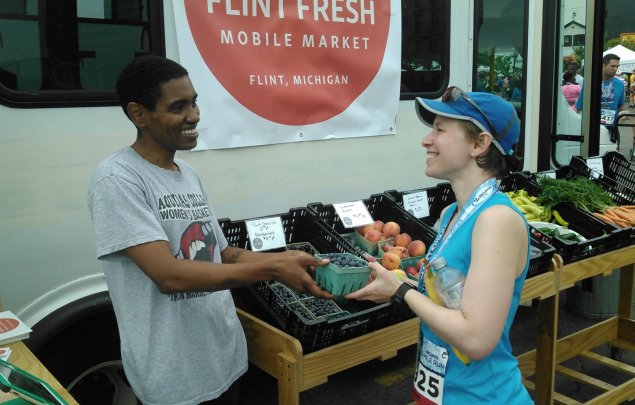Fresh vegetables — and starts
Takeaways
- “Access to healthy, affordable food” was identified as the second highest priority health need in the community health needs assessment (CHNA) process
- Community health needs assessment process and implementation strategies were focused on “communities of concern” which were identified as areas with the worst health outcomes
- In 2016, Eden Medical Center’s partnership with Dig Deep Farms helped them distribute 1,500 community-supported agriculture (CSA) bags to families in Ashland and Cherryland through partner organizations working with young people and also with people reentering the community from the county jail.
- Hospital Name: Eden Medical Center
- Hospital Type: Private, nonprofit
- Hospital Size: Medium (130 beds)
- Geographic area: Castro Valley, California in Alameda County
- System/Network: Sutter Health
- Network coverage: California and Hawaii
(Alameda County unless otherwise noted1)
- White (non-Hispanic or Latino): 32.1%
- Black or African American: 11.6%
- Asian: 30.2%
- Hispanic or Latino: 22.5%
- American Indian, Alaska Native: 1.1%
- Native Hawaiian, Other Pacific Islander: 1.0%
- Minority:2 66%
- Community health needs assessment region: 10 zip codes in Alameda County. The major cities in the hospital service area include Ashland, Brookshire, Cherryland, Fairview, Hayward, Russell City, and San Leandro.
- Population: 371,612
- Adult obesity (Alameda County): 19.8%
- mRFEI (CC range3,4): 5.0 - 37.5
- Living in poverty (CC range): 8.4 - 18.4%
- Unemployment (CC range): 11.1 - 16.0%
- ED Visits due to Diabetes (CC range): 293.5 - 455.7 per 10,000
Eden Medical Center (EMC) is located in Castro Valley, California which is the largest unincorporated community in Alameda County. The hospital first opened in 1954 and joined with Sutter Health in 1997, moving into a new facility in 2012. The hospital service area is defined by 10 zip codes that are home to more than 370,000 residents. Its western boundary is the San Francisco Bay.
The service area is racially and ethnically diverse with all but one zip code being majority non-white or Hispanic or Latino. The median income ranges from $56,656 to $138,447. Given the wide range of socioeconomic conditions and health outcomes within its service area Eden Medical Center focused their community health needs assessment (CHNA) and implementation strategy on “communities of concern” where the health disparities were starkest.
Community health needs assessment overview: Priorities and process
- Food and diet-related disease priorities:
- 2013 CHNA - a) Nutrition b) Health Literacy
- 2016 CHNA - Access to Affordable, Healthy Food
- Participation from food-based organizations in CHNA process: food pantry focus group
- How/why did food issues emerge as a priority?:
- Lack of access to healthy food was consistently a theme in the qualitative data, especially when discussing root causes of high rates of chronic disease.
- Qualitative themes listed in the CHNA included: Costs of healthier foods relative to fast food; Number of and availability of fast food restaurants; Limited availability of fresh food outlets; Stress as the main driver of poor nutrition; and Cultural influences on diet and nutrition.
- Key community indicators:
- Unemployment - All of the "communities of concern" zip codes have higher unemployment rates than the Alameda County rate of 10.3%
- Diversity - The majority of residents in 9 out of 10 hospital service area zip codes are Hispanic or Latino or non-white
- Food environment - “So you have a community that on every corner just about has liquor stores, but no fresh food” - Key informant
Full assessment: Eden Medical Center community health needs assessment
Assessing health needs
Community health needs assessment process
Eden Medical Center worked with Community Health Insights (CHI), a CHNA consultant, who had completed their 2013 CHNA and held a depth of understanding of their community and hospital system. In 2013, CHI identified “communities of concern” that had particularly poor health outcomes and were experiencing health disparities. The focus of the 2016 CHNA was to prioritize improving health within those communities. The consultant conducted the CHNA from start to finish, including the data collection, analysis, and prioritization process.
The CHNA defines "communities of concern" as “geographic areas within the hospital service area that have the greatest concentration of poor health outcomes and are home to more medically underserved, low-income, and diverse populations at greater risk for poorer health.”
Factors that were considered in the identification of these areas included the use of the Community Health Vulnerability Index, a tool that CHI adapted to determine the extent to which health disparities were present in a given geographic area. Communities of concern were also selected based on mortality and morbidity rates.
The analysis brought four zip codes to the front as "communities of concern" that represented about 55.3 percent of the total hospital service area. These zip codes were geographically at the center of the hospital service area and clustered together. The findings from the secondary data were confirmed by key informants (including local community health experts and service providers) who identified the neighborhoods associated with the four zip codes; Ashland, Cherryland, and San Lorenzo, as highest need:
According a key informant in the 2016 CHNA, “The immediate surrounding area of Sutter Eden encompasses the unincorporated areas. Many of those neighborhoods: Ashland, Cherryland, San Lorenzo, they have no mayors, no government, are very diverse, and (have) relatively low-income to very low-income populations.”
Key informants also identified specific racial and ethnic groups within the communities of concern that were experiencing poor health outcomes, including “Hispanic/Latinos, African-Americans, Pacific Islanders, new immigrants with limited English skills, and undocumented residents,” and noted that African Americans were consistently the group with the most significant disparities in health.
The significant health needs were identified based on quantitative and qualitative data collected by CHI and then analyzed using Robert Wood Johnson’s County Health Rankings Model. The health needs that were consistently at the top were reviewed for each community of concern and then prioritized based on coverage and intensity of the health need.
Access to affordable, healthy food was identified as the second of nine priority health needs. The consultant used the Department of Agriculture Food Desert Maps and Modified Retail Food Environment Index (mRFEI) to demonstrate the food environment but the qualitative data really told the clearest story.
— Key informant (2016 CHNA)
Qualitative themes that came out in the assessment included: the ubiquity of fast food restaurants, higher cost of healthy food compared to fast food, and limited availability of fresh food outlets.
Key informant and focus group participants consistently pointed to nutrition, limited health literacy related to nutrition, and unsafe living conditions limiting exercise, as contributors to chronic diseases in their communities.
Investing in solutions
Implementation strategy
The implementation strategy was driven by the internal community benefit team at Eden Medical Center, building off of the strategy from the previous cycle with final approval by the Sutter Health Bay Area Board. The hospital proposed strategies to address five of the nine significant health needs, including access to affordable and healthy food.
All of the strategies rely on strong relationships with community partners who are working effectively within identified communities of concern. The 2016-2018 implementation strategy was the first — in the 10 years of available data — to prioritize access to affordable and healthy food.
In selecting the community partner for the implementation strategy, the community benefit lead looked to the existing strengths within the community, identifying Dig Deep Farms as an organization doing impactful work that could benefit from the support of a hospital partner.
Eden Medical Center is one of 24 hospitals in the Sutter System, which has facilities in California and Hawaii. Every year, Sutter Health gives each hospital in their system money to donate to the food pantry of their choice. In 2016, a regional cluster of three Sutter hospitals including Eden Medical Center donated $12,500 to the Alameda County Food Bank, $12,500 to the food pantry at Davis Street Family Resource Center in San Leandro and $25,000 to the Contra Costa County Food Bank. In addition, they donated $10,000 to Loaves and Fishes in Contra Costa County to be used for their meal distribution program and their culinary arts education program that prepares high school students for careers in the culinary industry.

Dig Deep Farms
Dig Deep Farms is a social enterprise that is creating workforce development opportunities for local residents, particularly those coming out of the criminal justice system. The farm provides access to healthy food to people in the surrounding communities.
- Program type: Urban farm and community-supported agriculture
- Program administrator: Dig Deep Farms
- Program founded: 2010
- Hospital role: Provide grant support
- Community partners: Deputy Sheriffs’ Activities League, REACH Ashland Youth Center, La Clínica’s Fuente Wellness Center, and the Alameda County Sheriff’s Office Operation My Home Town reentry program
- Population served: San Leandro (Ashland and Cherryland)
- Program goals:
- Create job and workforce development opportunities for local residents, particularly those coming out of the criminal justice system.
- Provide access to healthy food to the surrounding communities.
- Expand the local food economy.
- Health needs addressed: Access to affordable, healthy food
- Program highlights:
- Eden Medical Center built a new relationship, helping them address their prioritized need for healthy food as well as connect to the high-need community members reentering from the county jail in EMC’s service area.
- Provided 1,500 community-supported agriculture bags and 120 nutrition classes to young people at La Clínica Fuente Wellness Center as well as reentry clients from Operation My Home Town over one year.
- Grant provided an important boost, allowing Dig Deep Farms to expand their Food as Medicine program which led to partnerships with larger collaboratives and other hospitals.

Project description
Dig Deep Farms (DDF) is a social enterprise built as a partnership between two Alameda County communities (Ashland and Cherryland), the Alameda County Sheriff’s Office, and the Deputy Sheriffs’ Activities League. The core goals of the program are to:
- Create job and workforce development opportunities for local residents, particularly those coming out of the criminal justice system.
- Provide access to healthy food to people living in the surrounding communities.
- Expand the local food economy.
Dig Deep Farms currently operates three farm sites on seven acres of land and distributes their produce to restaurants, the Hayward Wellness Center Food Farmacy, and in community-supported agriculture (CSA) bags as part of their Food as Medicine programs. They originally distributed their CSA bags to paying customers throughout the county but found it was more mission-aligned to use this distribution model for Food as Medicine programs. This enabled DDF and their strong network of community partners to get healthy, locally grown food to people who need it. Dig Deep Farms was started in 2010 and continues to grow to meet the nourishment and economic needs of their community.
Operation My Home Town (OMHT) is a reentry program for inmates at Alameda County’s Santa Rita Jail who are returning to the unincorporated communities of Ashland and Cherryland as well as other parts of the county. The program focuses on inmates who are at risk of recidivism, offering case management while they are still in jail including pre-release assessment, intervention, and reentry planning, and then connecting clients to community-based partners for internships and continued care once they are released. Dig Deep Farms has been one of those internship sites over the years, providing job training and CSA bags to OMHT clients.

Sarah Kirnon, manager of Dig Deep Farms, explains plans for the future of the farm. (Terry Lorant)
"This program, it's about empowering people, it's not just keeping people in a place where they're only getting a paycheck. It's about transition for folks who are looking to turn their life around."
— Sarah Kirnon, Dig Deep Farms manager
22,000 people re-entered Alameda County from jail or prison in 2010 according to an OMHT report. Ashland and Cherryland, the area immediately surrounding EMC, and two of their communities of concern, are home to only 8.5 percent of the county’s total population. However, over one-third of all reentering former inmates are from and return to this area.
This demonstrates the high need for effective reentry programs in the area as well as the challenging environment faced by community members. The Eden Medical Center CHNA does not directly acknowledge the reentry population, however, their partnership with Dig Deep is a key first step in working to address the specific needs experienced by this group.
Dig Deep also works in close partnership with the REACH Ashland Youth Center which was built from a youth-led, Alameda County Sheriff’s Office supported, grassroots effort to have a safe place in their community to spend time after school. REACH houses La Clínica’s Fuente Wellness Center, a teen health clinic serving youth between the ages of 11 and 24. Fuente Wellness Center distributes Dig Deep CSA bags to its clients paired with recipes and cooking classes taught by La Clínica staff. The cooking classes give the young people coming to the center an opportunity to learn how to prepare nutritious meals with locally grown ingredients which they are then able to share with their families.
Partnership and hospital role
The partnership between Dig Deep Farms and Eden Medical Center began when community benefit lead, Ellen Carroll, went online to find out more about the existing food assets in her service area. She also met with a member of the Alameda County Board of Supervisors to get the lay of the land. Both of these inquiries led her to Hilary Bass, Executive Director of the Deputy Sheriff’s Activities League, the nonprofit arm of the Alameda County Sheriff’s Department that houses Dig Deep Farms. She set up a meeting with Bass at the farm to learn about their programming and the gaps that existed which could possibly be filled by a hospital partnership.
“Ellen spent time to fund something that is integral to an operation’s success rather than starting a new thing. [It has been] so valuable to work with a funder in that manner because it is supportive of the organization and is a route to a successful achievement of goals. How do we support our internal growth to be able to do this over time? She listened and then she fought for it.”
— Hilary Bass, Dig Deep Farms
Eden Medical Center is one of a strong core group of partners engaged in what has become Dig Deep Farms’ Food as Medicine program. The medical center purchases CSA bags that are then distributed through Dig Deep partner organizations. The program started through a collaboration with the Alameda County Public Health Department, funded by the Kresge Foundation, to prescribe healthy food to pregnant women at risk of gestational diabetes at a health clinic in Ashland. The program was successful and led to more partnerships with similar aims, including La Clínica’s Fuente Wellness Center and their current partnership with Hayward Wellness Center.
After Carroll met with Bass, she knew the program was a great fit for EMC’s support. She advocated internally for a new and innovative partnership for the hospital. Fuente Wellness Center is operated by La Clínica, which is one of EMC’s local federally qualified health centers.
“Dig Deep wanted to provide food bags to the clients that were coming into Fuente Wellness Center, which is located within the Ashland Youth Center. Fuente Wellness’ patients are all teens (or I think up to 24 years old) and many of them are pregnant or young parents, and the clinic manager created a wonderful nutrition program for them using Dig Deep bags. She had them team up and make food with the ingredients from the bags, and compete with each other to see who could make the best stuff. Participants in the Ashland Youth Center’s other programs were the judges.”
— Ellen Carroll, Eden Medical Center
Once they created a program that connected La Clínica patients and OMHT clients with healthy food, they got the approval of the hospital CEO. Including some education about the proper use of the emergency department helped as well to convince hospital leadership of the program’s importance. This ensured that the hospital could address their access to healthy food priority in their implementation strategy while also building capacity at a local farm.
Dig Deep’s expanding work on Food as Medicine brought them to the table of a multi-sector collaborative called All-In Alameda, aimed at eliminating poverty in Alameda County. With Dig Deep leadership at the table, Food as Medicine rose to the top as a priority for the collaborative.
They teamed up with a physician from University of California San Francisco (UCSF) Benioff Children’s Hospital to develop a one-year Food as Medicine pilot with 60 families with children at high risk for diabetes. The pilot included four months of food prescriptions for whole grains and fresh produce, filled by the Alameda County Food Bank and Dig Deep Farms, and delivered directly to the family’s homes. The healthy food was paired with cookbooks and cooking classes provided by the Alameda County Public Health Department. The pilot ended in summer 2017 and the report on the outcomes of the research are forthcoming. However, early results showed an increased interest in local foods and CSA shares, as well as health improvements in the parents, some of whom showed reductions in waist circumference and other biometric measures.
Financing
Dig Deep Farms has a diverse funding stream that has included support from multiple health care entities in the area namely Eden Medical Center and Kaiser Permanente. The bulk of their funding, however, comes from Social Services and Assembly Bill 109, which directs funds to support the diversion of low-level offenders and parole-violators into county jails instead of state prisons.
Program evaluation methods and impacts
In 2016, EMC developed an evaluation system for their community benefit programs. The quantitative data for Dig Deep Farms is mainly participation information collected by La Clínica and OMHT, including number of cooking classes provided, connections to mental health and social services, number of persons case managed, and number of food prescriptions filled. With their grant from EMC, Dig Deep was able to provide 1,500 CSA bags and 120 classes in 2016.
The qualitative data for 2016 demonstrates the impacts of the program beyond the individual to families and loved ones. For some OMHT clients, having a bag of produce to bring home served as a bridge for repairing strained relationships. In addition, OMHT clients who worked on the farm received job skills and financial stability which the evaluation noted is an important step in the reentry process and helps reduce the chances of recidivism.
For the young people at La Clínica, participation in the program allowed them to share the lessons from their cooking classes as well as the fresh produce with their families. The evaluation also highlighted an increased comfort and confidence in preparing meals with vegetables that may have been new to them.
As a process reflection, Dig Deep leadership noted that the programmatic shift to Food as Medicine helped the employees feel more invested in the work on the farm. Redefining the products of the farm as “medicine” for community residents in need added a sense of value and importance to the work that had been missing for some employees, allowing them to feel better connected to both the produce they were growing and the people who would consume it.
Lessons learned and next steps
Over the last year, Dig Deep has been restructuring to better support their land and employees, as well as to gear up to expand their operations to include a food hub. Farm manager and renowned Bay Area chef, Sarah Kirnon, has been in charge of this process. According to Kirnon, it has been imperative to address the power dynamics that exist when working with people reentering from the criminal justice system while simultaneously operating as a program of the Sheriff’s Office. One of the challenges of working with the reentry population is participants’ ability to consistently come to the farm on a daily basis as they navigate the other stressors associated with reentry. The leadership at Dig Deep realized they could not provide the level of training and support needed for their staff at that time while also maintaining a healthy and viable enterprise.
Restructuring under Sarah’s leadership has allowed Dig Deep to still hire locally and build the health of the farm to eventually host a more supportive internship environment for OMHT clients. In the next year, Dig Deep Farms has plans to open a 3,000 square-foot food hub that will help work towards their vision of expanding the local food economy.
The food hub will be a space to incubate new and existing local food businesses and initiatives as well as provide up to 300 jobs, training, and internship opportunities. Dig Deep will also be launching a new 5-acre farm site in Union City which will almost double their production. The produce will then be aggregated at the food hub for distribution with priority for the Food as Medicine programs.









